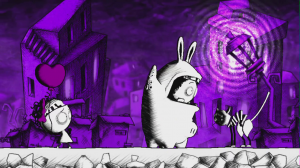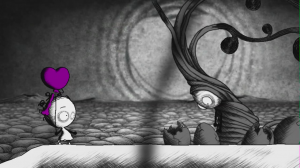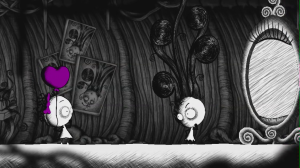Liverpool Sound and Vision Rating * * * *
Murasaki Baby is a side scrolling platform adventure game available for download from the PlayStation Store for the PS Vita. The game was announced at GamesCom 2013 to much acclaim and anticipation, so the ultimate question entering the release must be; can the final build of the game stand up to the hype?
The story of Murasaki Baby sees the lead character that is abstractly referred to as Baby rather than a distinctive name being lost a nightmarish world full of her worst fears as she explores various moods in an attempt to find a way back into the safety of her mother.
Baby is always carrying a balloon that must be protected as the inflatable represents her health. Therefore, the balloon is arguably the most important gameplay mechanic as if it is lost or is popped, then Baby will die and players will have to restart from the most recent checkpoint.
The level design is very imaginative as it depicts a nightmarish world in which Baby will be happy one moment and terrified the next with an appropriate use of the art style to create atmosphere. The puzzles really help to bring the level design along with such brainteasers as removing a light bulb from one chain and placing it on the other to make the colony of bats flee their roost, so Baby can progress beyond the bats and having to use a particular mood to produce rain to raise the positioning of the boat in order for Baby to jump onto it.
 The character design is just as creative as the level design as players will encounter flies with paper clips attached to them that will lurch forward very suddenly in an attempt to quite literally burst Baby’s balloon, while there are various characters that will be met albeit very briefly on most occasions which all seem to have their own problems regardless of how large or small along with their personality traits, but it helps to give a sense of scale to the game and tell the story that Baby is not the only person who has found themselves in this nightmarish world, which in itself provides the feeling of hope that it may be possible to find a way back to reality.
The character design is just as creative as the level design as players will encounter flies with paper clips attached to them that will lurch forward very suddenly in an attempt to quite literally burst Baby’s balloon, while there are various characters that will be met albeit very briefly on most occasions which all seem to have their own problems regardless of how large or small along with their personality traits, but it helps to give a sense of scale to the game and tell the story that Baby is not the only person who has found themselves in this nightmarish world, which in itself provides the feeling of hope that it may be possible to find a way back to reality.
The control scheme is quite easy to master as it purely revolves around the touch screen and rear touch pad. The control scheme consists of swiping the touch screen to guide Baby along by the hand; swiping the touch screen to return Baby’s balloon to her; tapping the touch screen to temporarily get rid of enemies such as the flies with paper clips attempting to burst Baby’s balloon; swiping the rear touch pad to change the mood of the surrounding environment; and tapping the touch pad to make Baby and her enemies jump with fear, shock and surprise.
Murasaki Baby’s graphics are arguably its main standout feature as it really paints an extremely vivid depiction of the nightmare Baby is experiencing as the artistic side of the game shines through with a dazzling cross shaded hand drawn style that is just as creative as such games as Limbo, while there are certainly Tim Burton influences too and the tension of each mood is illustrated as accurately as players would expect them to feel if a person was experiencing them in real life, which really brings a symbolic quality to the game that resonates with many people in everyday life situations.
 The presentation is so minimalist in its appearance to a point that it could be argued if it has any to begin with as players are immediately thrust into the game as there are no menus or options and all of the control schemes are located in the separate manual, while the lack of a pause menu is quite strange and unorthodox to say the least, although the presentation is somewhat redeemed by the use of clear and concise diagrams showing how to perform certain actions when new gameplay elements are introduced and some may say that with exception of the pause menu; the lack of menus perhaps helps the pacing of the game.
The presentation is so minimalist in its appearance to a point that it could be argued if it has any to begin with as players are immediately thrust into the game as there are no menus or options and all of the control schemes are located in the separate manual, while the lack of a pause menu is quite strange and unorthodox to say the least, although the presentation is somewhat redeemed by the use of clear and concise diagrams showing how to perform certain actions when new gameplay elements are introduced and some may say that with exception of the pause menu; the lack of menus perhaps helps the pacing of the game.
The audio consists of sound effects, speech and music, which collectively make for quite an atmospheric tone to the game as the sound effects consist of ambient sounds related to which environment Baby is exploring, such as rain and thunder, a spinning windmill or fire, while there are nearby creatures, such as bats and flies, amongst others with footstep and balloon related sounds. The speech is limited in the sense that Baby is too young to be speaking properly, although she will make noises to reflect her happiness, excitement or horror, while the music is interlaced here and there for effect, especially when Baby dies.
 The trophy list includes eleven trophies with five bronze, five silver and one gold trophy. The vast majority of the rewards are fairly easy as nine trophies are story related, therefore they will be earned by naturally progressing through the story, while the They Can’t Get Along bronze trophy and the Murasaki Baby gold trophy are the only two trophies that are missable. The They Can’t Get Along bronze trophy can be earned by unveiling and looking at all of the pictures in the Twisted Twins’ home, while the Murasaki Baby gold trophy requires players to simply watch the end credits, so even though they are missable trophies; they are not really difficult to earn as long as players are aware of where to look at the pictures and to not skip the end credits sequence. It is estimated that depending upon skill, a good trophy guide to provide some helpful tips and that it would take between two to five hours to 100% the trophy list.
The trophy list includes eleven trophies with five bronze, five silver and one gold trophy. The vast majority of the rewards are fairly easy as nine trophies are story related, therefore they will be earned by naturally progressing through the story, while the They Can’t Get Along bronze trophy and the Murasaki Baby gold trophy are the only two trophies that are missable. The They Can’t Get Along bronze trophy can be earned by unveiling and looking at all of the pictures in the Twisted Twins’ home, while the Murasaki Baby gold trophy requires players to simply watch the end credits, so even though they are missable trophies; they are not really difficult to earn as long as players are aware of where to look at the pictures and to not skip the end credits sequence. It is estimated that depending upon skill, a good trophy guide to provide some helpful tips and that it would take between two to five hours to 100% the trophy list.
There are no difficulty levels, although there is a distinct difficulty curve as new dangers are introduced from enemies to hazards and new gameplay elements are also introduced periodically that will usually be tied into the puzzles and level design that retain a flow to the game, while keeping everything moving along at an interesting yet appropriate pace.
There are no multiplayer features or online leaderboards and while the lack of multiplayer is not exactly surprising given the time clearly invested into the atmosphere and creative aesthetic; it would have been a positive step in the right direction to see a form of pass the Vita co-operative multiplayer, so that the control of Baby switches between multiple players after she has died and online leaderboards displaying a listing of who has completed each chapter of the game and the overall game in the fastest times to add some form of co-operative and competitive features.
The soul form of replayability that Muraski Baby possesses is its unique and charming style as there is nothing else to guarantee that players will return beyond the initial playthrough due to a lack of any focus on unlockable content, multiplayer or online leaderboards, which is a shame as it is really the only sideways step made throughout the entire game. The lack of alternative game modes or something fundamental to keep players coming back is highlighted all the more by being able to complete the game in around two to five hours depending upon how quickly players grasp the puzzles and control scheme, while it must be asked how many times players could return to a game for its unique and charming style alone, although it is probably a game that many will return to too explore everything over again every now and then.
Overall, Murasaki Baby is a creative platform adventure with a solid story and great pacing that is certainly recommendable to anyone who enjoys the platform or adventure genres and is good value for money at only £7.99, despite lacking in longevity, but more than making up for it in original artistic style and substance.
Jason Bonnar
Analysis
- Title: Murasaki Baby
- Developer: Ovosonico
- Publisher: Ovosonico
- System: PS Vita
- Format: PSN Download
- Cross-Buy: No
- Cross-Play: No
- Players: 1
- Memory Card Space Required: 328MB